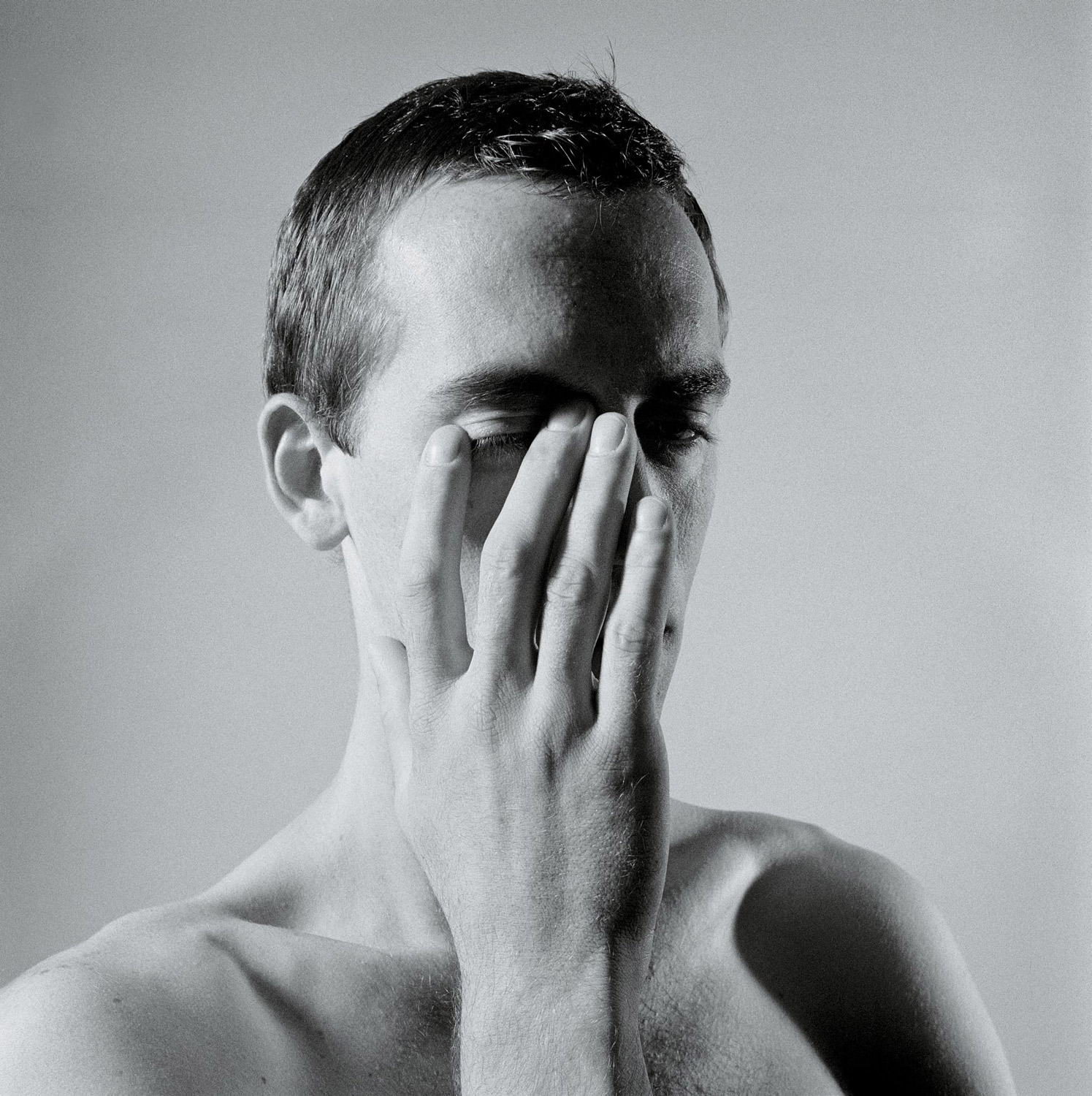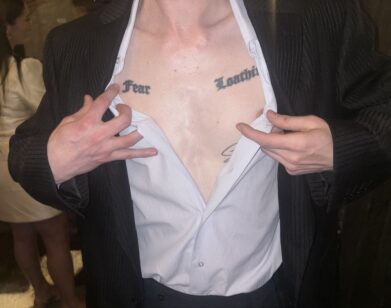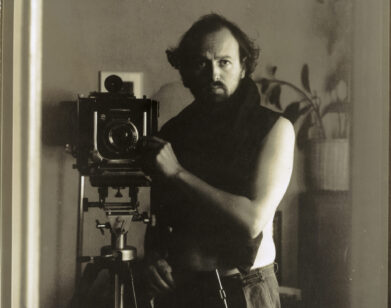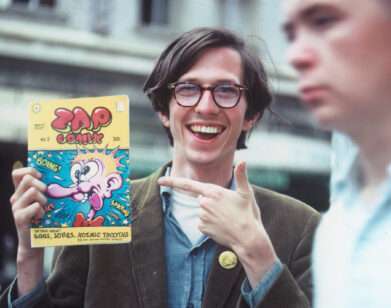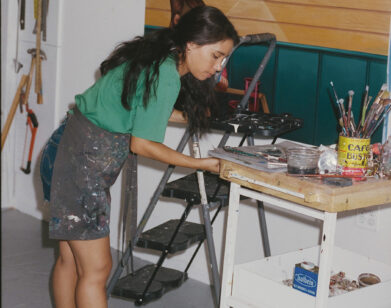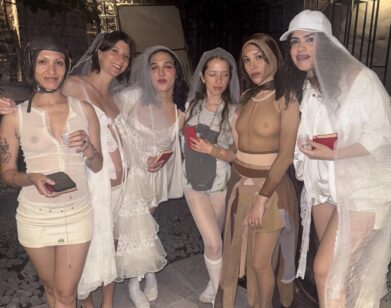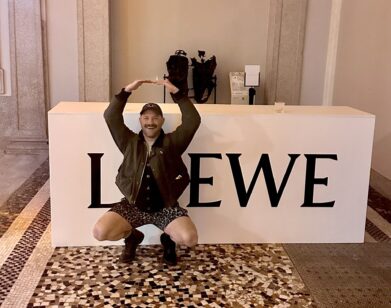David Wojnarowicz
Over the years, I’ve periodically found myself in situations that felt desperate and, in those moments, I’d feel that I needed to make certain things.David Wojnarowicz
In December 2010, 18 years after his death, David Wojnarowicz became world famous again. The sudden notoriety was due to an uproar over his 1986–87 Super 8 art film A Fire in My Belly—specifically, an 11-second sequence that showed Mexican fire ants crawling around and over a crucifix. A Fire in My Belly had been part of the gay-identity exhibition “Hide/Seek: Difference and Desire in American Portraiture” at the Smithsonian’s National Portrait Gallery, and the outcry—spearheaded largely by the Catholic League—resulted in the Smithsonian deciding to remove the work from the show. For those in the art world, this brazen censorship of a complicated and invaluable work seemed like something out of the culture wars of the last century: Surely, artistic institutions had learned their lessons from the embarrassing Robert Mapplethorpe trial of 1990 and refused to fold under the pressure of a right-wing religious minority who hadn’t taken the time to understand Wojnarowicz’s life and legacy. Sadly, the incident proved that freedom of expression had not come as far as most had hoped.
Wojnarowicz died of AIDS in 1992 at the age of 37, so it is impossible to say with certainty how he would have reacted to the suppression. Nevertheless, the gawky, gay, deep-voiced downtown New York City art-world pioneer who is furiously drawn in Cynthia Carr’s new biography Fire in the Belly: The Life and Times of David Wojnarowicz, out in July from Bloomsbury, suggests that he wouldn’t have taken it quietly. Here is what he wrote about a similar rejection in the late ’80s: “I’m in the throes of facing my own mortality and in attempting to communicate what I’m expressing or learning in order to try and help others I am effectively silenced. I am angry.”
Wojnarowicz was fearless when it came to self-expression—fearless about his work and fearless about showing it. The only thing that might have incensed him as much as those who responded with knee-jerk conservatism were those who bought his work as an investment opportunity and didn’t respond to its emotional textures at all. Wojnarowicz proved to be one of the prickliest, most mercurial, hard-to-pin-down experimenters of American art. It is no small achievement that Carr, who first met the artist when he was part of the East Village art scene of the early ’80s, shortly before she began writing for the Village Voice, has managed to portray him in remarkably rich dimensions. Carr’s book takes us through a nearly four-decade roller coaster of contemporary bohemia, beginning with Wojnarowicz’s horrifically abusive childhood, his early life on the streets of New York as an urban explorer and hustler, and his initial explorations of alternative expression. Wojnarowicz’s prodigious talent as a writer (he kept journals and penned monologues in his voice and those of fellow drifters he met) served as a gateway to other mediums—painting, film, sculpture, photography, graffiti, and flagrant combinations thereof. He famously raged and recorded at the inception of the early-’80s East Village art-world scene, a hardcore, down-and-out, and (for a while) truly liberating alternative to the money markets of the SoHo and uptown galleries. There couldn’t have been a better artist to represent that short-lived movement, where neo-expressionism met inner-city dystopia. For Wojnarowicz was not only an outsider by nature, he reveled in that status and celebrated his own fringe view almost shamanisticly. His works address annihilation, disenfranchisement, depersonalization, and dread, but as much as they invoke the big ideas of a world gone wrong, they also record the artist’s own fears, memories, and demons. In a way, all of his works could be read as self-portraits.”
Carr’s detailed research into Wojnarowicz’s days and nights, friends and fall-outs, hook-ups, loves, losses, travels, homeless stretches, intimate connections (photographer Peter Hujar being the golden mentor figure in his life), and eventual sickness and death is both heartbreaking and unflinchingly honest. Carr has managed to create not only an essential biography but required reading for anyone interested in the ’80s art world.
Of course, the 2010 National Portrait Gallery incident might not have surprised Wojnarowicz at all. In 1990, he famously sued the right-wing American Family Association for using images of his work out of context and for defamation, setting a precedent for protecting the future rights of artists to control the use of their own imagery. That legal victory, along with his exquisite but often hard to locate, rarely exhibited body of work, has for so long been Wojnarowicz’s signal legacy. Thankfully, Carr’s biography tells the rest of the story, one where through poverty, drugs, and AIDS, few survived. In the following three excerpted sections, we follow the artist through his mid- to late twenties, at the very start of his visual art career. —Christopher Bollen
In the late ’70s, David Wojnarowicz began photographing his “Rimbaud in New York” series. Friends and lovers posed throughout the city wearing an Arthur Rimbaud mask that Wojnarowicz fashioned from the iconic portrait of the poet on the cover of Illuminations. Wojnarowicz worked on this project for roughly a year, amassing about 500 images. The first of these photographs were taken at or near the Hudson River piers west of Greenwich Village.
The first thing David covered in his journal after his return, on June 6, 1979, was a trip with Brian [Butterick, Wojnarowicz’s close friend] to the West Village—“its immediate visual effect,” which he doesn’t describe except to agree with his ex-roommate Dennis DeForge’s assessment: It’s an outdoor whore house. “Don’t think I’ll ever forget that initial sense of shock.” He didn’t elaborate, but clearly he wasn’t talking about cruising on Christopher Street. He meant the piers, which would become the center of his life for the next year and a half. These rotting treacherous structures along the Hudson River provided cover for acres of public sex. The waterfront from Christopher to 14th Streets was the unofficial gay men’s playground. Separating the piers from the edge of the Village was the elevated West Side Highway, which had been closed to traffic since ’73 but still provided shelter to transvestite hookers among its stanchions. On the city side of the highway were gay bars like the Ramrod, Peter Rabbit, and Alex in Wonderland. This big libidinous play district included the trucks parked along the highway every night and somehow never locked. David would surely have been familiar with this area. He’d been frequenting the nearest dive coffee shop, the Silver Dollar, since his street days with Willy [a street buddy during his teen years], but he usually picked up men on the streets or in bars. The piers could be dangerous, not just because they were falling apart and pockmarked with holes open to the river. Men had been murdered there. For many, the lawlessness and risk only added to the excitement. This was an autonomous zone.
Sex among the ruins—David found it fascinating. He wanted to cruise the piers, but he also wanted to paint them, photograph them, and record what happened in them. Soon he was back with Brian and a can of spray paint. He drew a crude Rimbaud face on a windowpane. On a wall, he sprayed a male torso shooting up with a big hypodermic needle. Elsewhere he painted a target. Then he sprayed a kind of a haiku onto a wall: “Did you watch the dogfight yesterday (under Mexican sky).” He graffitied a line often quoted by William Burroughs: “ ‘There is no truth / Everything is possible’ Hassan I Sabbah” and added his own 10-line poem underneath, beginning, “Some men gun fast trucks down red roads / Down into distant valleys where mountains / Are slowly eaten by deserts.”
David had one short-lived minimum-wage job that summer. In mid-June, an ad agency trained him to print photographs and to run a photostat machine. They fired him when he almost immediately started using his sick days. But while there, he was able to photostat the cover of Illuminations to create a life-size mask of Arthur Rimbaud.
Rimbaud was a kind of lodestar for David at this point in his life. He identified with the poet. They’d been born a hundred years apart—Rimbaud in October 1854 and David in September 1954. Both were deserted by their fathers and unhappy with their mothers. Both ran away as teenagers. Both were impoverished and unwilling to live by the rules. Both were queer. Both tried to wring visionary work out of suffering. David just didn’t yet know the rest—that he would soon meet an older man and mentor who would change his life (as Paul Verlaine had changed Rimbaud’s), and that he too would die at the age of 37.
He began photographing Rimbaud in New York that summer with a borrowed camera, using Brian as his model. In 1990, the first time these photos were exhibited as a series, David told an interviewer from the New York Native, “I felt, at that time, that I wanted it to be the last thing I did before I ended up back on the streets or died or disappeared. Over the years, I’ve periodically found myself in situations that felt desperate and, in those moments, I’d feel that I needed to make certain things . . . I had Rimbaud come through a vague biographical outline of what my past had been—the places I had hung out in as a kid, the places I starved in or haunted on some level.”
Brian posed in the Rimbaud mask on 42nd Street between Seventh and Eighth Avenues, a block then lined with porn theaters. He stood in front of dangling cow carcasses in the meatpacking district. He rode a graffiti-scarred subway. He spent quite a bit of time at the Hudson River sex piers and wandered among various other crumbling eyesores. He posed at the dancing-chicken booth in Chinatown. He stood outside the Terminal Bar. He shot heroin.
David wrote two “35mm photo scripts,” with dozens of ideas for the poet’s adventures. He had a narrative in mind. Rimbaud would arrive by ship, alighting at the Brooklyn Navy Yard in one script and at Coney Island in the other. Eventually he would die of a heroin overdose. Most of these scenarios were never photographed—like Rimbaud eating in the Salvation Army cafeteria, Rimbaud inside Port Authority, Rimbaud making rude gestures at St. Patrick’s during mass—probably because David lacked money for film and processing. Usually he economized on what he did shoot. Rimbaud on the subway: two exposures, one printed. For the heroin shot, he removed the needle and replaced it with a pin, its point inside the hypo, which he’d glued to Brian’s arm. “The head of the pin was pressed into the flesh,” Brian said. “It looked like it was in the flesh.
Everything became groundless, apt to fall apart at any moment, nothing offering security or permanence.David Wojnarowicz
John Hall [a friend of Wojnarowicz’s since high school] also took part in the Rimbaud project, though he doesn’t remember when. He posed at the piers and in the meatpacking district as Brian had. (David used the images of Brian from those locations.) He was also Rimbaud wounded (bandaged hand) and Rimbaud with a Dubuffet sculpture. Most famously, though, John Hall was Rimbaud masturbating. He remembers nothing about where this photo was taken or how it came about, only that David put him at ease when he thought he was too skinny and didn’t have a good body. Brian thought the photo might have happened when David went to photograph Hall’s apartment, whose disarray he found fascinating. Indeed, David even described the place in his journal: “The hurricane dive that seems to be John’s symbol, obsessively in turmoil . . . the clash of headlines and food containers and loops of stereo wires and bass guitar—piles of papers sliding down hills of music magazines and newspapers. Posters of the Slits and James White on the walls—ashtrays of cigarette butts from guests who came and departed weeks ago.” The Ludlow Street building was so old and decrepit that, according to Hall, tenants had been known “to fall through their living room floors into the apartment below.”
When Jean Pierre [Delage, Wojnarowicz’s first serious boyfriend] came to visit, David quickly incorporated him into the project as well. JP became Rimbaud at Coney Island. JP remembered going two or three times. They’d leave at 5 a.m. to get there when it was deserted. He remembered the black jacket and white T-shirt he wore. Alone on the beach. Alone at the closed kebab stand. Alone in front of the parachute drop. JP could not remember where they stayed. Not Brooklyn, he thought. David still hadn’t found a place to live.
Early in the 1980s, Wojnarowicz met famed New York photographer Peter Hujar, beginning a relationship between the two artists that would last for the rest of their lives. Hujar, already well established for his black-and-white portraits and cityscapes, would serve as mentor, lover, confidante, and close friend.
On January 4, 1981, David wrote to JP that he’d “spent the night talking with a new friend about life/photos, etc.—rare that I have a chance to just talk and listen to interesting things.” On the 7th, he again mentions “new friends” and how certain people inspired him to keep working. On the 9th, he finally named a particular new friend: Peter Hujar—and that he enjoyed talking with him about “photography, life, etc.” It’s quite possible that they actually met in late December. Naturally, David never discussed his sexual escapades in letters to Jean Pierre. If he ever referred to those men, they were “friends” and not named. Hujar was in a singular new category David couldn’t have named at that point. Hujar would prove to be the most important person in his life.
Early in January, David learned that one of his photos had been chosen for the Foto Gallery exhibition, though what he mostly felt was disappointment that the judges had not picked his portrait of JP. Instead, they’d chosen a picture he’d taken outside the Beaubourg of a kid with James Dean tattooed across his back. This same photo was set to appear on the cover of Sounds in the Distance [stories he’d overheard or collected from usually marginal characters], and that week he also learned that William Burroughs himself had agreed to blurb his little book. David didn’t seem happy or even impressed by any of this.
His life now was “desperate, surreal, awful, and slightly wondrous,” he wrote in the journal he’d barely touched since the Danceteria bust [Danceteria, the club where Wojnarowicz worked as a busboy, was raided by police in October 1980 and shuttered]. He finally went back to it on January 21, 1981, trying to make sense of things. After the bust, it seemed, “everything became groundless, apt to fall apart at any moment, nothing offering security or permanence.” He noted: “It wasn’t just the arrests or the eventual loss of work, but rather a period of time in which I grew tired of all the scenes I’d been involved with.” He wrote about meeting Hujar in the Bar at Second Avenue and 4th Street. “He stared at me and I looked back several times. I guess I wanted him in a strong way.” When they got to Hujar’s loft at Second Avenue and 12th Street, he handed David a book, saying, “This is the kind of work I do.” David was stunned to see a volume he’d been drawn to years before—Portraits in Life and Death. Hujar’s photographs of artists, drag queens, and others who intrigued him were utterly straightforward and empathetic. Along with his friends, Hujar included photographs of mummies in the catacombs at Palermo.
They may not have exchanged last names at the Bar, but David now knew very well who this was. “Hujar” appears, mysteriously, on a list David made in August 1979 while working on the Rimbaud photos, along with items like “brian’s collage/pistol” and “parakeets in woolworth’s”—and across from each of these, a film speed.
What ever that was about, David felt that he had an image of Hujar the artist that blocked him from seeing Hujar the person. But over a series of days David let that dissipate. And then what he saw in Hujar was a kind of mirror image; they were both desperate and confused, but David felt he still had hope about the future, and Hujar did not. Maybe because David’s art was still developing, while Hujar’s art was fully formed and his career had never flowered.
David showed Hujar some of his work, but doesn’t say what. Rimbaud? The portrait of JP? The monologues? What ever it was, Hujar seemed disinterested or maybe just unaffected. At least, that was David’s impression, though it would prove to be untrue. In any situation that was even slightly ambiguous, he would seize upon the worst interpretation. One night, he stopped by Hujar’s loft to film him for his first Super 8 movie, Heroin—silent, three minutes long, and one of the only films David ever completed. If Hujar made the final cut, he played one of the people passed out or dead on various floors and sidewalks. David said only that he left the loft that night feeling a lot of anger about the state of his own work, feeling that he was basically a failure, that he wasn’t “capable of affecting change in anyone other than friends.” But then, he asked himself, what was it that he wanted to change? Maybe his images were too aggressive. “I seem to really desire some way to seduce people, make them feel at ease and yet make them renounce all the terrible things of the earth and say: Yes, this is what is true.”
On the day he did this journal writing—January 21, 1981—Hujar called to tell him he had syphilis. So David went and got his shot and wrote, “[I] am in a state of pain and reexamination of all I once held as my life, not because of the shot but because of the weariness of all these daily routines . . . But I continue the only ways I know how, always with looking over my shoulder for that chance to change direction and run, escape, depart.”
It was a depressive’s reaction, but something had lit a fire in him. Susan Gauthier [then one of his roommates] observed that David’s life definitely changed when he met Hujar. “Someone saw that [David] was a true artist.” She couldn’t quite articulate how it changed except to say that David was “full-on” after that, in regard to his work—and he stopped going constantly to the pier.
Truly, everything was beginning for him, but David couldn’t see it. Early in February, he learned that Keith Haring had selected him for two group exhibits he was curating, one at Club 57 (“The Erotic Show”) and one at the Mudd Club (“The Lower Manhattan Drawing Show”). He was also in rehearsals for a first gig with his band, 3 Teens Kill 4 – No Motive. And at the end of the month, Dennis Cooper’s journal, Little Caesar, finally appeared in bookstores with 16 Rimbaud photos and two monologues. This on top of winning the photo contest and finding a publisher for Sounds in the Distance.
David fixated on the glass half-empty, on the fact that he still spent most of his waking hours as a busboy and was in love with a man he rarely saw.
In the early ’80s, the East Village art scene established itself in makeshift galleries along the blighted, drug-infested blocks east of Avenue A—an art world all its own, part postmodern and part punk. Wojnarowicz was involved with two well-regarded galleries that set the tone, Civilian Warfare and Gracie Mansion Gallery. It was in this budding scene of energy and expression (and accelerated marketing) that Wojnarowicz, along with downtown artists like Keith Haring, Nan Goldin, and Kenny Scharf, first got a toehold in the New York art world.
The East Village was the art world’s surly teenager, ready to tromp all over the unspoken etiquette established in “grown-up” galleries. No one would walk into Leo Castelli’s space and ask, “How much is that Rauschenberg?” It wasn’t done. Money and status were the elephants in such rooms where top dealers sold top artists to top collectors. In the East Village, prices were discussed right up front. Often you could get something for $50 or $100. A completely sold-out Rodney Alan Greenblat show at Gracie Mansion had work starting at five dollars. I once saw a dealer get work out of some dinky back room, spread it over the floor, and ask, “Is this the right size? Want something in blue?” Then, the East Village galleries were not just open on Sunday—but that was their big day. At openings, most of the artgoers were actually out in the street, since so few could fit inside. And at Civilian Warfare, gallerist Dean Savard always served vodka, never white wine. What was not yet called “branding” revolved around such superficialities. At the same time, the whole East Village setup was a critique of elitism. When I wrote, in 1984, about what was happening in my neighborhood, I declared that new ideas were being explored here about what a collector, a dealer, an artist, and a gallery could be. Looking at it after more than 25 years, I’m not sure anything really changed. The art world has a magical ability to absorb every critique, and make money on it.
Ultimately 176 galleries would open in the neighborhood (not all at once, obviously). Landlords were eagerly endorsing this unlikely trend by offering former bodegas and social clubs—and sometimes apartments for the dealers—at remarkably low rents. I’ll never forget the young dealer who took me to her filthy, unheated apartment a few doors away from her gallery, served me instant Bustelo in a dirty cup, and then announced, “This is how we live on the Lower East Side.” She’d lived there for six months, after growing up on the Upper East Side. Poverty was apparently a cool new lifestyle, but it wouldn’t be for long. As this dealer proudly declared, “We’re raising the property values.”
Gracie Mansion [formerly Joanne Mayhew-Young] had started her career as a dealer by looking at the mechanisms involved in presenting and selling art, and she set up another sly commentary in September ’83 with her “Sofa/Painting” show. Because when you’re not elitist, you end up dealing with art buyers at the other end of the spectrum, those who say, “I need something that looks good over the sofa.”
David was one of the six artists she invited to create both a sofa and a painting to hang above it. She gave each artist $25 or $50 to help in the purchase of a couch. David found one on the street— a legless banquette that might have come from a diner. He set it on two milk cartons. On the seat he placed a piece of Plexiglas, covered on one side with his complaint about the art world. Yes, he already had one: Too many people wanted to show him. Or, were “trying to seduce him,” as Gracie put it. That meant Civilian and Gracie and Hal Bromm [Gallery]. On the other side of the Plexiglas he obscured those words by painting red, green, and white branchlike forms along with a screaming head and a small image of his own head. On the back of the sofa, he painted a cityscape in black and yellow, with a globe in the sky. The painting on the wall above the sofa showed a figure climbing a tree with one stump of a branch. “It’s him, trying to get away from all of us,” Gracie explained.
David sold work in 1983 through all three of the galleries named and blamed above, earning a total of almost $17,000. He had a gross income of about $26,000 in ’84, but he was never rich. As usual, he embodied contradiction: he was irritated by the art world; he was also relieved that he finally had a way to make a living and worried that the whole thing could evaporate at any moment. David’s strange relationship with money began to manifest as soon as he made some. He would give it away without a second thought to a needy friend. Then sometimes, he’d be nearly broke again. He had no concept of financial planning. He never had a savings account. He never had an IRA. He did not have a credit card until almost 1990. Near the end of his life, he confessed to a friend that he had never known how to balance a checkbook. If possible, he would have avoided using money altogether. He preferred trading. He certainly would not consider making art just for money. But then, he wanted the purity of that intention to be matched by a purity of acquisition in collectors. They should care what the work meant! It made him angry, even disgusted, that people would buy work as an investment once it was validated by certain critics. Though he was never remotely as bad as Hujar on this score, his attitude led him into a certain amount of self-sabotage.
He could not walk easily into his success. He had begun to get very prickly.
On April 15, 1984, artist Mike Bidlo re-created Warhol’s Factory in the attic at PS1. Bidlo appeared as Warhol and spent the evening making silkscreen prints of Marilyn to give out gratis. Silver foil covered the walls. Naturally, the not-quite-Velvet Underground performed. Keiko Bonk—a painter, musician, and friend of David’s—put the band together and played Nico. Julie Hair [a member of 3 Teens] was John Cale while David played Lou Reed and sang a creditable rendition of “Heroin.” He also dropped acid for the first time in his life. Dean Savard wafted through the crowd dressed as Edie Sedgwick. Artist Rhonda Zwillinger appeared as Valerie Solanas. Many who’d been there commented later on the crush and the rhythmic bouncing on the floor—remembered indelibly because they thought it was going to collapse.
That month, David was engaged in finishing work for his show at Civilian. He had made 23 plaster heads with, as he put it, “a couple of extras that were separated from the series,” which he called “Metamorphosis.” They looked like the alien heads he’d started to include in a few paintings. No two were alike. A few were covered with maps or parts of maps, others were painted, the colors of the eyes changing “according to what colors mean spiritually,” he said. Then halfway through the progression, the heads showed signs of distress: bandages, blood, black eyes, incineration, and finally one “fell off the shelf.” A 24th head sat on the floor in a doctor’s bag, an old one. He said the piece was about the evolution of consciousness. With perhaps the attendant consequences. He’d been thinking, 23 genes in a chromosome; a 24th causes mongoloidism. (That was also the reasoning behind the story that was about to appear in Between C & D, “Self- Portrait in 23 Rounds.”) Some of the individual heads were photographed, but the piece as a whole was never documented. David threw one of the “extra” heads into the Hudson as a sort of offering.
He’d begun to refine his private symbol system. He continued to work with maps, which remained forever mysterious to him as an acceptable version of reality. Ripping them could be a metaphor for so many things, like groundlessness and chaos. He’d stopped working with garbage can lids and driftwood. The new sculptures used animal skulls, skeletons, mannequins. To look at David’s early work is to watch him figuring out how to be an artist. A painting he did in 1983 called The Boys Go Off to War is a kind of diptych, and the imagery is simple. On the left half are two men, naked to the waist, perhaps in a bar (since one holds a drink), perhaps lovers but at least friends (since one has his arm around the other). On the right are two gutted pigs. With the paintings he did for the 1984 Civilian show he was really beginning to develop his collage approach. For example, Fuck You Faggot Fucker features, again, a male couple. The background is all maps but the only one clearly visible is behind the couple at the center. Created with a stencil, they stand waist-deep in water, kissing. Directly below them is a scrap of paper found by David, on which some anonymous homophobe has written, “Fuck You Faggot Fucker,” around an obscene doodle. He’s embedded that in the painting. At the four corners are photographs: one of Brian Butterick as St. Sebastian, photographed at the pier; three of David with John Hall, naked at the Christodora.
David’s show with the plaster heads, other sculptures, and new paintings opened on May 5, 1984. Though none of the principals, including David, knew it at the time—this would be his last solo show at Civilian. I remember the opening because everyone stood out on 11th Street watching David inside, finishing the work. He’d hung the show earlier, placing the heads on a wall where he’d painted a big bull’s-eye. Then he left, and the 23 heads started to slide off their shelves. The wall was just Sheetrock with no studs. Savard and Marisa [Cardinale, the gallery’s manager] took them all down in a frenzy and rehung them on the opposite wall, where Savard repainted the bull’s-eye. Then they had to rehang everything else. David, who’d probably been sitting in some restaurant, came back furious. He didn’t like Savard’s bull’s-eye. I remember him standing inside with a paintbrush—opening delayed. What he said to me about it later, though, was that he liked the way that broke the art-world rules. You couldn’t go to an opening in SoHo or on 57th Street and find the artist still standing there with a bucket of paint.

